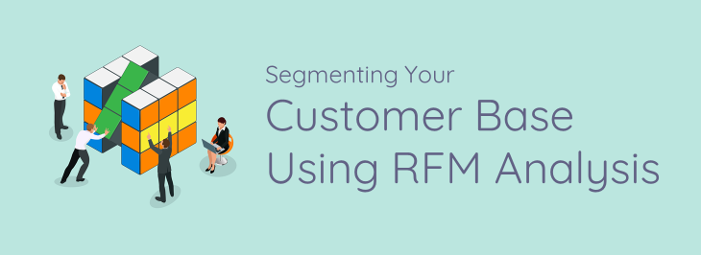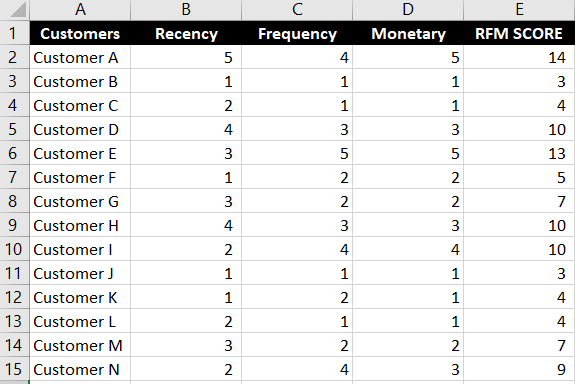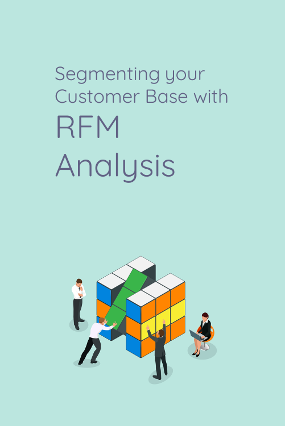
All your customers are not valued equally. Some customers are worth a lot regarding purchases and loyalty, while others are worth little to nothing. RFM analysis is customer based segmentation based on buyer behavior.
- Recency – the last time that a customer made a purchase. A recent purchasing customer is more likely to make another purchase than a customer who hasn’t purchased in a long time.
- Frequency – how many times a customer has made a purchase within a given time frame. A customer who makes frequent purchases is more likely to continue to purchase than a customer who rarely makes purchases.
- Monetary Value – the amount of money a customer has spent within that same time frame. A customer who spends more is likely to return than a customer who spends less.
When RFM segmentations is combined with a marketing automation software (e.g., Hubspot), you’ll be able to leverage this segmentation in real time to deliver the right content and offer to the right customer at the right time.
How to Segment Your Customer Using RFM Analysis

To perform an RFM segmentation analysis, export your customer data with the following columns by customer:
- Customer name
- First order date
- Last order date
- Number of orders
- Total revenue
Assign a RFM Score for Each Customer
The first step in building an RFM model is to assign a Recency, Frequency and Monetary (RFM) score to each customer. Scoring will vary depending on the degree you want to segment your customers. For this example, we will segment customers by quintiles (i.e., dividing your customer data into five groupings by RFM segment). For example, a customer base dataset might be scored in the following manner by RFM segment:
Example of RFM Scores by Segment
Order Recency Score
- Order Recency = 5 (ordered in the last 30 days)
- Order Recency = 4 (ordered in the last 31 to 60 days)
- Order Recency = 3 (ordered in the last 61 to 120 days)
- Order Recency = 2 (ordered in the last 121 to 180 days)
- Order Recency = 1 (ordered more than 181 days ago)
Order Frequency Score
- Order Frequency = 5 (14 or more orders)
- Order Frequency = 4 (between 9 and 13 orders)
- Order Frequency = 3 (between 4 and 8 orders)
- Order Frequency = 2 (between 2 and 4 orders)
- Order Frequency = 1 (1 order)
Monetary Score
- Monetary = 5 (ordered more than $351)
- Monetary = 4 (ordered between $201 and $350)
- Monetary = 3 (ordered between $151 and $200)
- Monetary = 2 (ordered between $51 and $150)
- Monetary = 1 (ordered less than $50)
Once you have established your scoring baseline, you can establish an RFM score for each customer.

How to leverage RFM Segmentation
It is helpful to assign names to segments and place them in groups. Here are just a few examples:
- VIP’s: This group consists of those customers with high monetary scores of 5 or 4.
- Call or survey this group to understand why they buy and stay loyal. Use this information to better serve them and profile this group to target new ones.
- Provide them “exclusive offers.”
- Surprise them with gifts in some of their orders.
- Enroll these customers into a loyalty program that rewards them for their loyalty.
- New Big Spenders – This group consists of recent customers who ordered once and bought a lot with scores such as: 5-1-5 and 5-1-4.
- Welcome them and make them feel special. For example, you could personalized welcome email with a coupon code to incentivise a repeat purchase.
- Enroll these customers into a loyalty program that rewards order frequency.
- Welcome them and make them feel special. For example, you could personalized welcome email with a coupon code to incentivise a repeat purchase.
- Lower Spending Loyal Customers – This group consists of those customers in segments 5-5-3 and 5-5-4 (they transacted recently and do so often, but spend the least).
- Create bundles that incentivize in context with prior purchases.
- Offer free shipping with larger order sizes.
- Provide cross-sell and upsell offers in context with prior purchases.
- Create bundles that incentivize in context with prior purchases.
- Disengaged Customers – This segment customers are found in groups R-1 and have not ordered in a long time.
- Create re-engagement campaigns to win this customers back.
Similar Posts:
Download the full report.









-3.jpeg?width=352&name=7%20Ways%20to%20Promote%20Your%20Blog%20(And%20Increase%20Traffic)-3.jpeg)